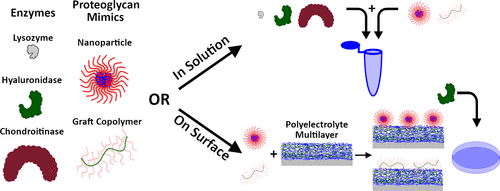当前位置:
X-MOL 学术
›
Biomacromolecules
›
论文详情
Our official English website, www.x-mol.net, welcomes your
feedback! (Note: you will need to create a separate account there.)
Enzymatic Degradation of Glycosaminoglycans and Proteoglycan-Mimetic Materials in Solution and on Polyelectrolyte Multilayer Surfaces
Biomacromolecules ( IF 5.5 ) Pub Date : 2021-08-04 , DOI: 10.1021/acs.biomac.1c00720 Jessi R Vlcek 1 , Melissa M Reynolds 1, 2, 2 , Matt J Kipper 1, 2, 3
Biomacromolecules ( IF 5.5 ) Pub Date : 2021-08-04 , DOI: 10.1021/acs.biomac.1c00720 Jessi R Vlcek 1 , Melissa M Reynolds 1, 2, 2 , Matt J Kipper 1, 2, 3
Affiliation

|
Proteoglycans (PGs) play many important roles in biology, contributing to the mechanical properties of tissues, helping to organize extracellular matrix components, and participating in signaling mechanisms related to mechanotransduction, cell differentiation, immune responses, and wound healing. Our lab has designed two different types of PG mimics: polyelectrolyte complex nanoparticles (PCNs) and PG-mimetic graft copolymers (GCs), both of which are prepared using naturally occurring glycosaminoglycans. This work evaluates the enzymatic stability of these PG mimics using hyaluronidases (I-S, IV-S, and II), chondroitinase ABC, and lysozyme, for PG mimics suspended in solution and adsorbed onto surfaces. Hyaluronan (HA)- and chondroitin sulfate (CS)-containing PG mimics are degraded by the hyaluronidases. PCNs prepared with CS and GCs prepared with heparin are the only CS- and HA-containing PG mimics protected from chondroitinase ABC. None of the materials are measurably degraded by lysozyme. Adsorption to polyelectrolyte multilayer surfaces protects PG mimics from degradation, compared to when PG mimics are combined with enzymes in solution; all surfaces are still intact after 21 days of enzyme exposure. This work reveals how the stability of PG mimics is controlled by both the composition and macromolecular assembly of the PG mimic and also by the size and specificity of the enzyme. Understanding and tuning these degradation susceptibilities are essential for advancing their applications in cardiovascular materials, orthopedic materials, and growth factor delivery applications.
中文翻译:

糖胺聚糖和蛋白聚糖模拟材料在溶液中和聚电解质多层表面上的酶促降解
蛋白聚糖 (PGs) 在生物学中发挥着许多重要作用,有助于组织的机械特性,帮助组织细胞外基质成分,并参与与机械转导、细胞分化、免疫反应和伤口愈合相关的信号机制。我们的实验室设计了两种不同类型的 PG 模拟物:聚电解质复合纳米粒子 (PCN) 和 PG 模拟接枝共聚物 (GC),两者均使用天然存在的糖胺聚糖制备。这项工作使用透明质酸酶(IS、IV-S 和 II)、软骨素酶 ABC 和溶菌酶评估这些 PG 模拟物的酶稳定性,用于悬浮在溶液中并吸附到表面上的 PG 模拟物。含有透明质酸 (HA) 和硫酸软骨素 (CS) 的 PG 模拟物被透明质酸酶降解。用 CS 制备的 PCNs 和用肝素制备的 GCs 是唯一受软骨素酶 ABC 保护的含有 CS 和 HA 的 PG 模拟物。没有一种材料被溶菌酶显着降解。与 PG 模拟物在溶液中与酶结合时,对聚电解质多层表面的吸附可保护 PG 模拟物免于降解;在酶暴露 21 天后,所有表面仍然完好无损。这项工作揭示了 PG 模拟物的稳定性如何受到 PG 模拟物的组成和大分子组装以及酶的大小和特异性的控制。了解和调整这些降解敏感性对于推进其在心血管材料、骨科材料和生长因子递送应用中的应用至关重要。
更新日期:2021-09-13
中文翻译:

糖胺聚糖和蛋白聚糖模拟材料在溶液中和聚电解质多层表面上的酶促降解
蛋白聚糖 (PGs) 在生物学中发挥着许多重要作用,有助于组织的机械特性,帮助组织细胞外基质成分,并参与与机械转导、细胞分化、免疫反应和伤口愈合相关的信号机制。我们的实验室设计了两种不同类型的 PG 模拟物:聚电解质复合纳米粒子 (PCN) 和 PG 模拟接枝共聚物 (GC),两者均使用天然存在的糖胺聚糖制备。这项工作使用透明质酸酶(IS、IV-S 和 II)、软骨素酶 ABC 和溶菌酶评估这些 PG 模拟物的酶稳定性,用于悬浮在溶液中并吸附到表面上的 PG 模拟物。含有透明质酸 (HA) 和硫酸软骨素 (CS) 的 PG 模拟物被透明质酸酶降解。用 CS 制备的 PCNs 和用肝素制备的 GCs 是唯一受软骨素酶 ABC 保护的含有 CS 和 HA 的 PG 模拟物。没有一种材料被溶菌酶显着降解。与 PG 模拟物在溶液中与酶结合时,对聚电解质多层表面的吸附可保护 PG 模拟物免于降解;在酶暴露 21 天后,所有表面仍然完好无损。这项工作揭示了 PG 模拟物的稳定性如何受到 PG 模拟物的组成和大分子组装以及酶的大小和特异性的控制。了解和调整这些降解敏感性对于推进其在心血管材料、骨科材料和生长因子递送应用中的应用至关重要。











































 京公网安备 11010802027423号
京公网安备 11010802027423号